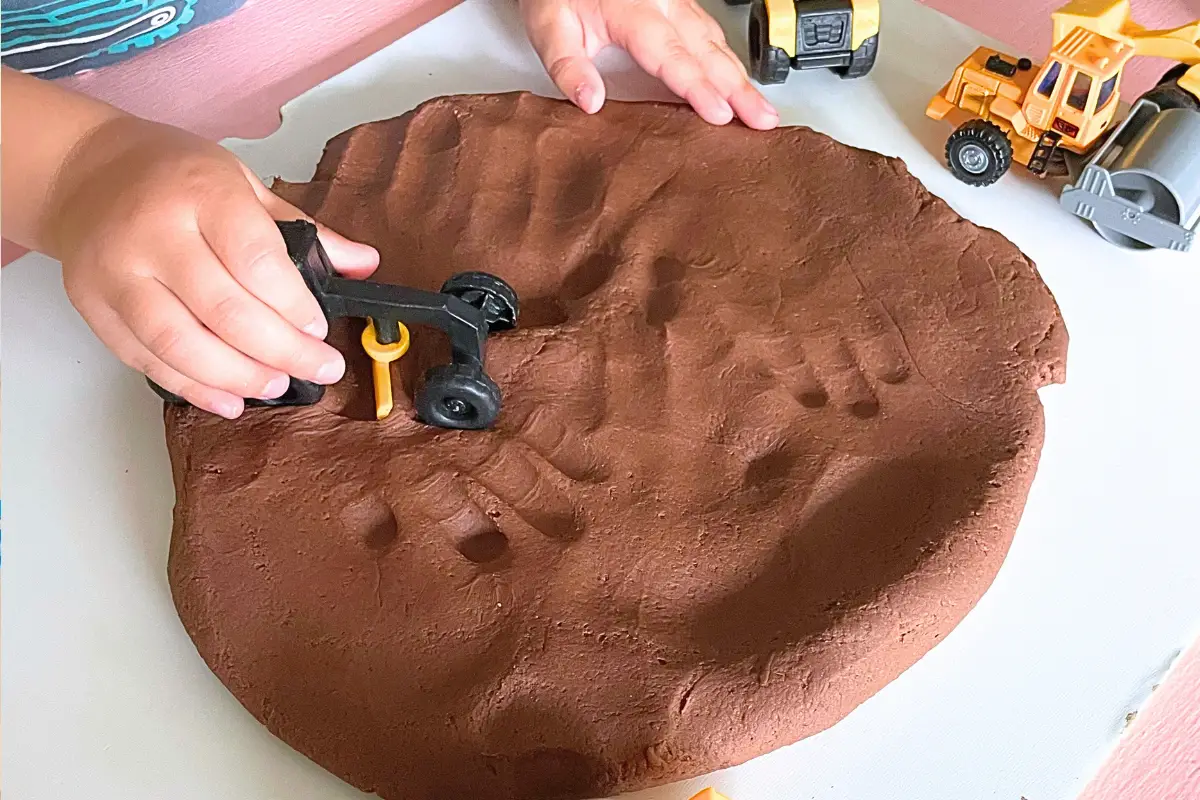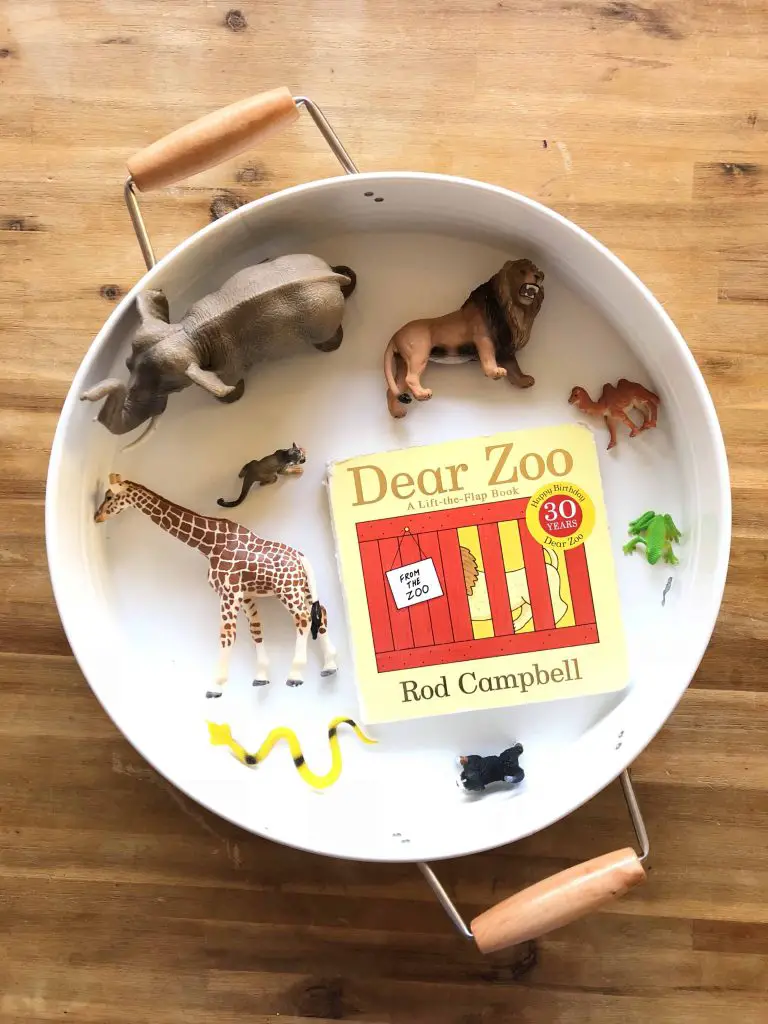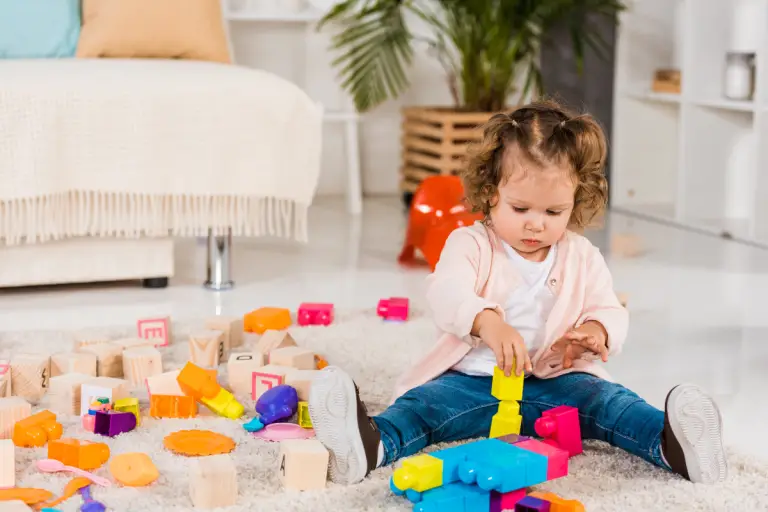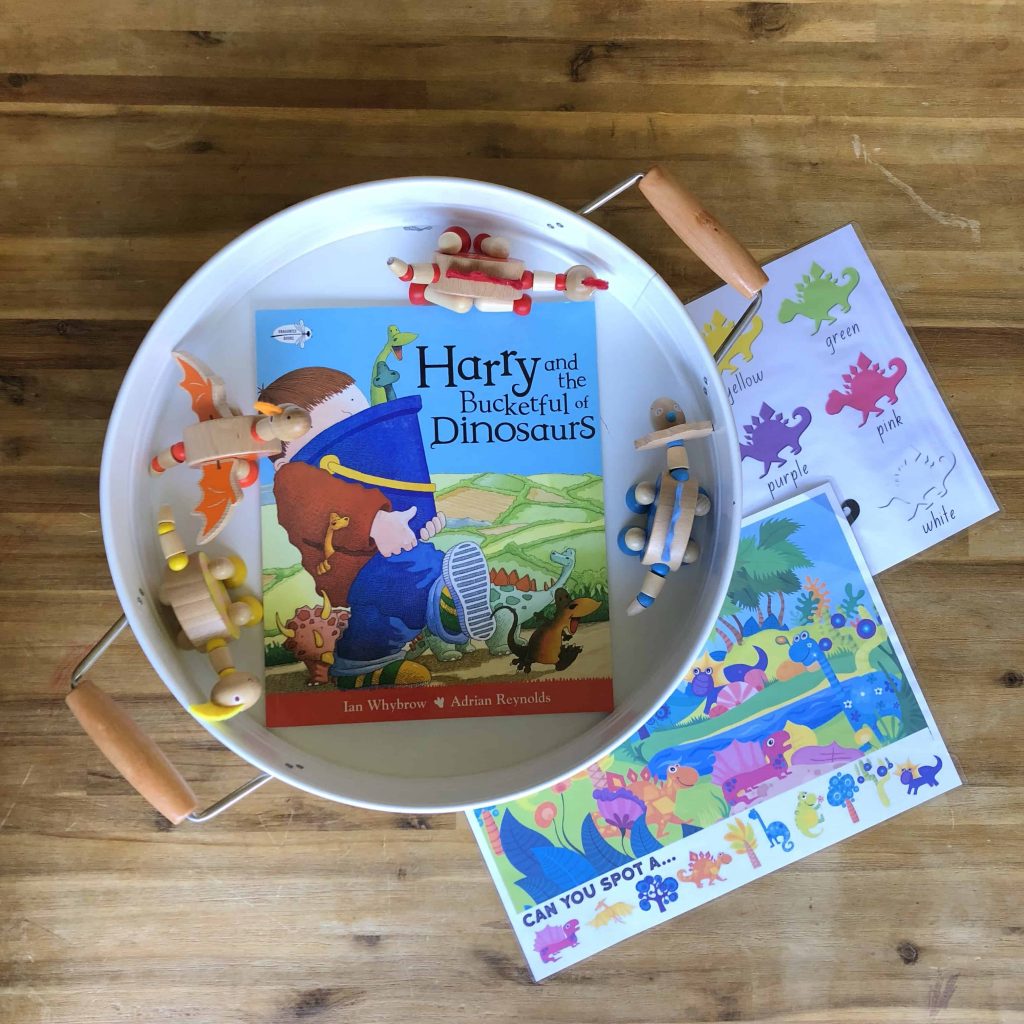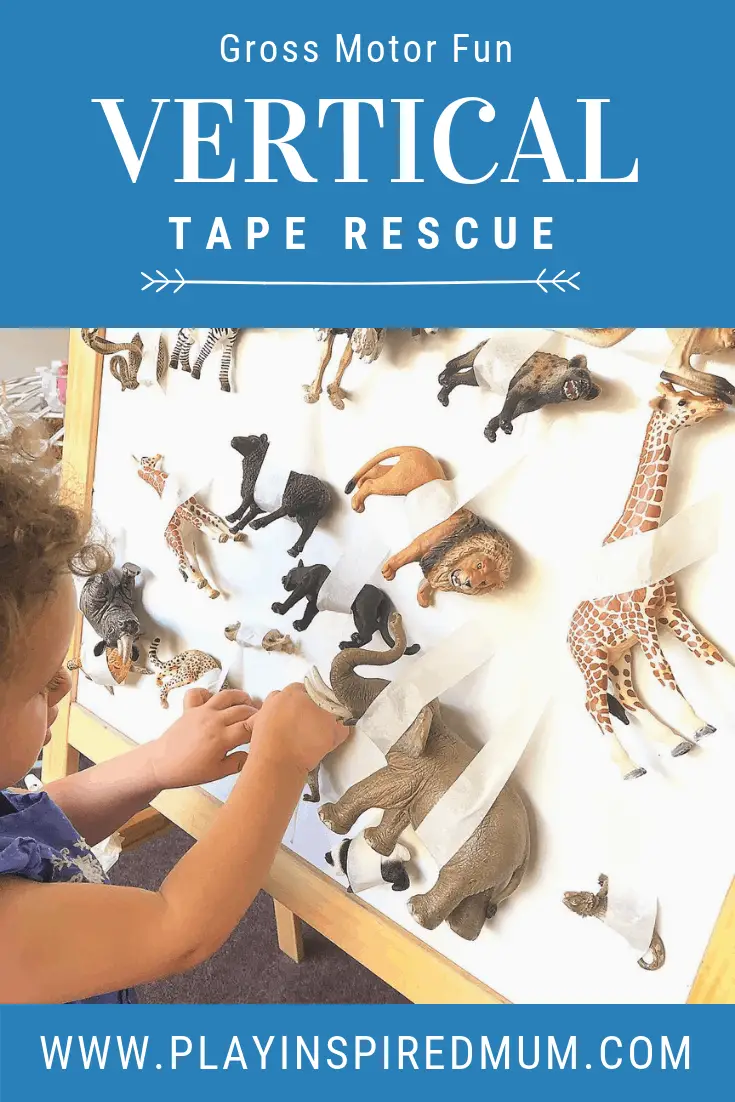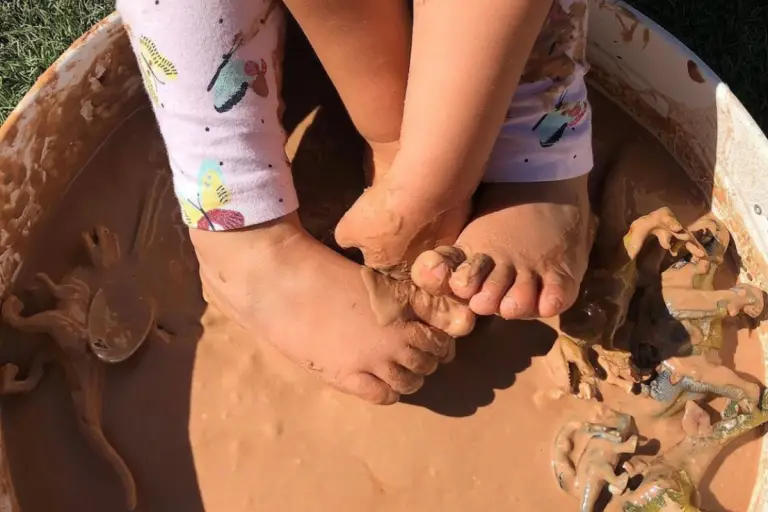Mastering the Art of Chocolate Play Dough: a Simple Guide
Disclosure: This blog contains affiliate links which I may earn a small commission from if you purchase through them, at no extra cost to you.
A stormy day meant play time was primarily indoors and what better way to celebrate the muddy puddles outside than with some deliciously scented chocolate play dough!
We have made brown play dough time and time again for many activities.
Our gingerbread play dough is perfect for Christmas and doubled beautifully as a muddy track for some cars.
We have added brown food colouring to our traditional home made play dough recipe for insect digs and fossil excavations.
This mornings play dough was inspired by the scent already wafting through the house after baking some chocolate chickpea cookies (don’t knock ’em til you try ’em).
With Mr 3 watching wide-eyed with his construction trucks in hand, we had some glorious chocolate play dough made in the same time it took for the kettle to boil.
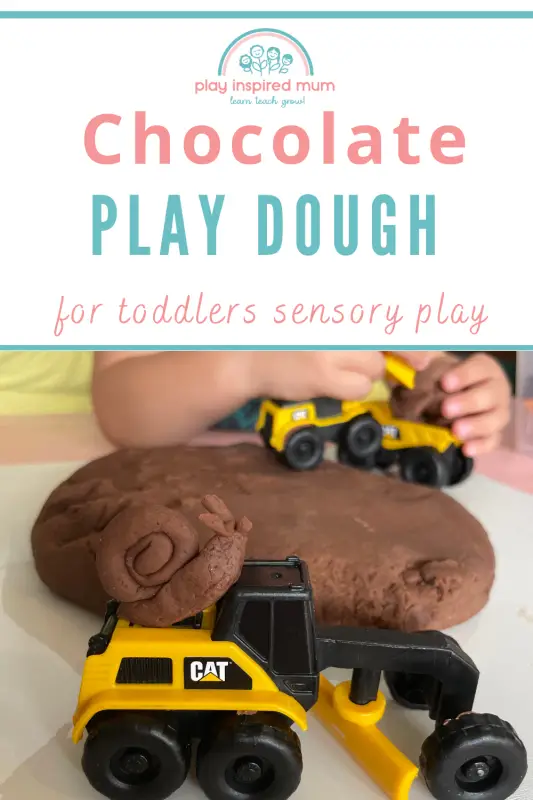
Introduction to Chocolate Play Dough
I discovered the art of making chocolate play dough by accident.
It was a rainy day activity that turned into a sensory play revelation for my toddlers.
Unlike the regular play dough, this homemade chocolate play dough offers a unique sensory experience.
The rich aroma captivates the senses, while the soft texture is a delight for little hands.
Making it at home not only proved to be cost-effective but also allowed us to tweak the recipe to our liking.
The process was surprisingly easy, requiring just a few key ingredients.
This versatile play dough activity quickly became our best ever chocolate play dough adventure, combining the joys of sensory play with the development of fine motor skills.
Why Chocolate Play Dough?
The allure of making homemade chocolate play dough lies not just in its delightful scent but also in its multifacategories benefits.
For those seeking sensory play activities, this easy play dough offers an unparalleled experience.
Its soft, pliable texture and chocolate fragrance engage the senses, making it a fantastic sensory play tool.
Beyond sensory exploration, chocolate play dough serves as a powerful means to bolster fine motor skills.
Kneading, rolling, and shaping this versatile play dough activity strengthens hand muscles and enhances coordination, preparing toddlers for tasks that require dexterity.
Moreover, chocolate play dough emerges as an ideal choice for rainy day activities.
It promises hours of entertainment, allowing for a creative and mess-free escape from the dreariness outside.
Whether it’s shaping whimsical creations or engaging in pretend play, this best ever chocolate play dough recipe transforms a mundane day indoors into an adventure in sensory and fine motor skill development.
For us it transformed our coffee table into a chocolate scented construction site, before being shaped into poops.
Yes, poops.
Toilet training is in full swing, and normalising poop is all part of the process.
Key Ingredients
Gathering the right components for our chocolate play dough ensures the activity will be both fun and successful.
I’ve found this concoction to be the best ever, especially on a rainy day or when in need of a versatile play dough activity.
The sensory play benefits, along with the boost to fine motor skills, are unmatched.
- Flour: This base ingredient will give the dough its form and texture.
- Salt: Salt acts as a preservative, extending the life of our play dough.
- Cocoa Powder: Provides the chocolate scent and colour, making it irresistible.
- Cream of Tartar: Helps in elasticity, ensuring the dough is easy and fun to manipulate.
- Warm Water: Bonds the dry ingredients together into a pliable substance.
- Vegetable Oil: Adds softness to the dough, making it easier to shape.
- Glycerol: Makes the play dough stretch further before breaking
Prepare these ingredients in advance to ensure our chocolate play dough session is effortless and enjoyable, especially for toddlers eager for sensory play.
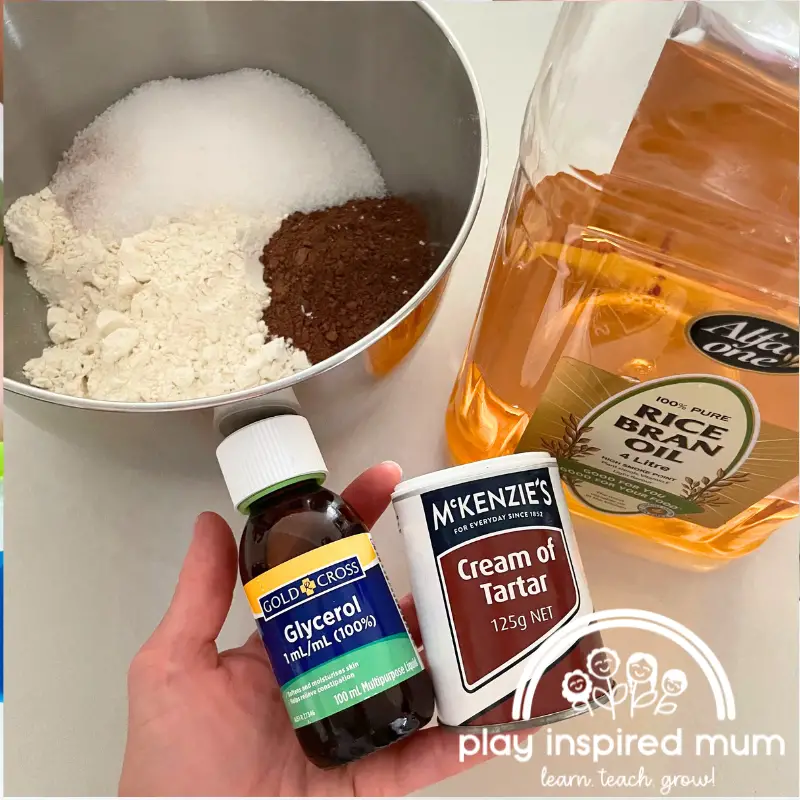
Step-by-Step Guide
I found that making homemade play dough isn’t just cost-effective.
It’s a delightful sensory play activity.
In my quest for the best ever chocolate play dough, a simple, versatile recipe stood out.
I gathered easy-to-find ingredients: flour, cocoa powder, salt, cream of tartar, oil, glycerol and boiling water.
Mixing these created a dough that smelled divine, looked tempting, and felt softer than any store-bought alternative.
First, I combined the dry ingredients, making sure no clumps remained.
Then, carefully, I mixed in the wet components.
The transformation was fascinating.
Initially sticky, the mixture soon morphed into a supple dough as I kneaded and it cooled.
When it felt too sticky, a sprinkle of flour corrected the texture.
Too crumbly?
A dash of water brought it back to perfection.
This process, ripe with adjustments, taught me the versatility of this toddler activity.
It was a rainy day savior, providing endless amusement and a rich sensory experience.
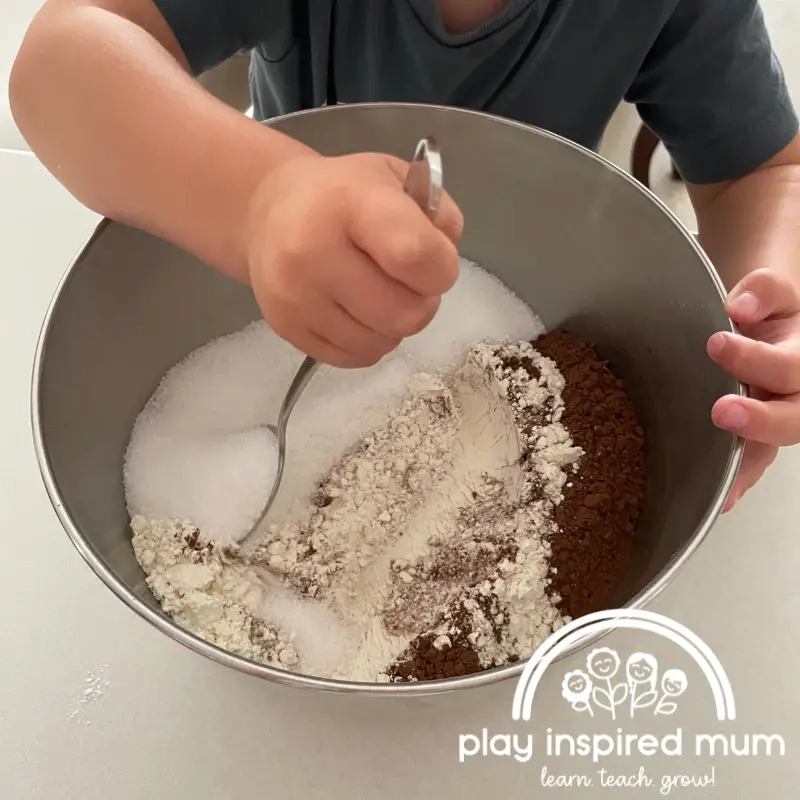
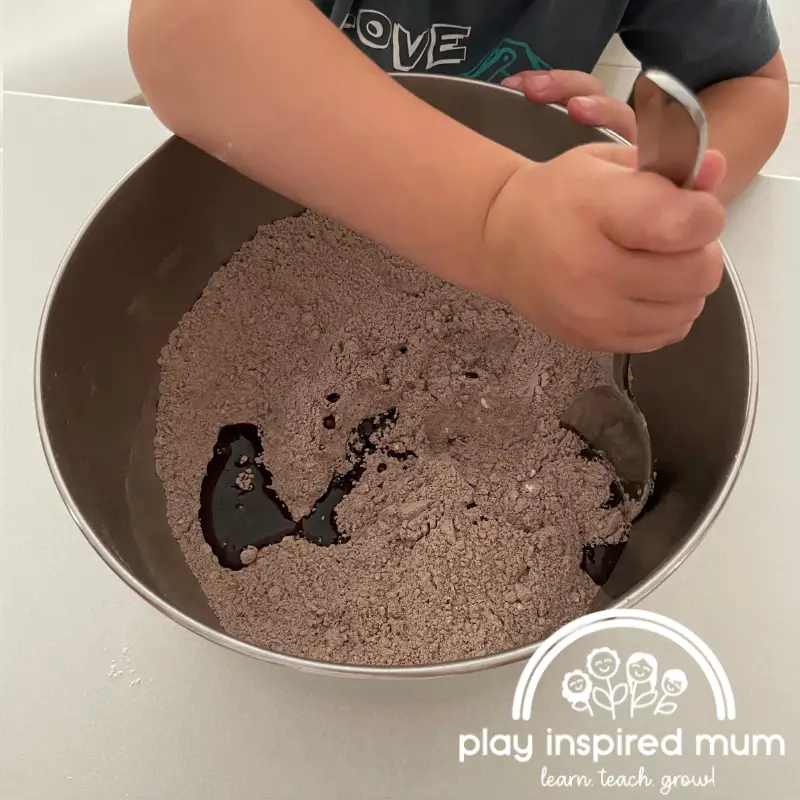

Troubleshooting Tips
Making the perfect batch of homemade chocolate play dough might sometimes seem tricky.
I’ve encountered batches that were too sticky or, on the contrary, too dry.
Here’s how you can fix these common issues and adapt the recipe to work best in your specific environment, ensuring a versatile play dough activity every time.
- If your dough turns out too sticky, the solution is simple. Just sprinkle a bit more flour into the mix and knead. A few adjustments here, and you’ll feel the texture transform under your fingers.
- For dough that’s too dry, adding a splash more water or vegetable oil will do the trick. The right balance will bring back that easy play dough consistency that’s perfect for sensory play.
- Consider your environment. Factors like elevation or the type of water in your area (hard versus soft) can affect your play dough. If you’re living at a higher altitude, you might find that adjustments to the amount of liquid or flour will be necessary. Listening to what the dough tells you makes all the difference.
Remember, crafting the best ever chocolate play dough is not just about following a recipe. It’s about engaging with the materials, understanding the sensory experience, and embracing the process as a journey of discovery, perfect for boosting fine motor skills during a rainy day or as an energizing toddler activity.
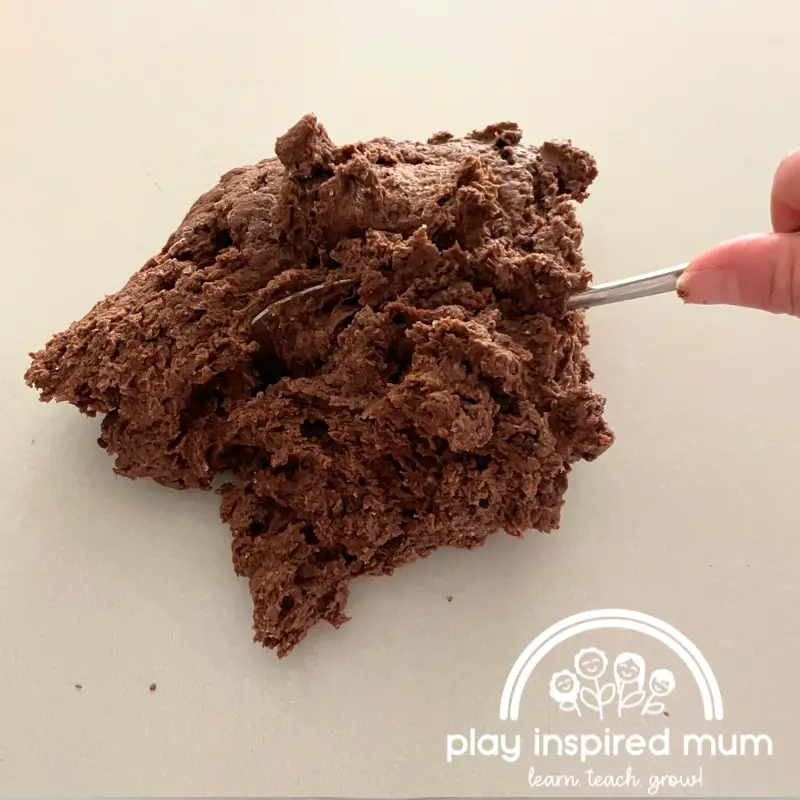
Best Easy Chocolate Play Dough Recipe
- 2 Cups plain flour
- 1 Cup Salt
- 1/2 Cup Cocoa
- 2 Tablespoons Cream of Tartar
- 3 Tablespoons Oil
- 1 Teaspoon Glycerol
- 2 Cups Boiling Water
Step 1: Mix dry ingredients
Step 2: Mix in wet ingredients. Remember to take care – its hot!
Step 3: Wait for the dough to cool before kneading until smooth and then time to play!
Enhancing the Experience
Making chocolate play dough at home is so easy.
It has became an engaging activity, not just for toddlers, but for me as well.
I discovered the versatility of play dough activities spans far beyond simple sculpting and there is nothing better than kneading fresh homemade play dough.
By incorporating various play dough tools, creativity and sensory play thrived in my home.
We used rollers, cutters, and even stamps to transform this soft, chocolatey dough into miniature masterpieces.
One day, I decided to organize a versatile play dough activity focusing on fine motor skills.
We rolled, pinched, and patted the dough, marveling at its texture and how easily it could be shaped.
For a rainy day activity, we ventured into making pretend chocolates.
This not only kept us entertained for hours but also allowed us to explore different shapes and sizes.
Homemade play dough, especially the chocolate variety, proved to be the best ever sensory play resource, inviting endless possibilities for creativity and fun.

Valentine’s Day Activity Ideas
Valentine’s Day brings us a perfect opportunity to engage toddlers and young children in sensory play that not only entertains but also aids their development.
Using homemade chocolate play dough can transform an ordinary day into a fun and imaginative learning experience.
Imagine the joy on little faces as they roll, shape, and mold their very own chocolate creations.
I have discovered that this easy play dough serves as an excellent base for a themed activity.
For instance, children can make pretend chocolates, which they then package in tiny boxes or wrap in colourful foil, mimicking the look of real Valentine’s Day chocolates.
This versatile play dough activity not only enhances fine motor skills but also stimulates creativity and cognitive thinking.
The process of making these pretend chocolates allows for an exploration of shapes and sizes, teaching children about variation and symmetry in a highly interactive manner.
The simple addition of homemade chocolate play dough to your Valentine’s Day celebration will enrich the learning environment, making it a memorable and enjoyable sensory play experience.
Storing Your Play Dough
I found that homemade chocolate play dough not only unleashes a sensory adventure but also calls for proper storage to keep its delightful texture.
Here’s the trick: seal it tightly.
Yes, wrapping your play dough in plastic wrap isn’t enough.
I discovered placing it in an airtight container or a ziplock bag works wonders.
This method ensured my play dough stayed soft and pliable much longer than expected.
For those who want to take their storage game up a notch, consider the refrigerator.
A cool environment can extend its life even further, making it ready for fun, time and time again.
Remember, the goal is to maintain its best ever chocolate scent and easy-to-mold consistency, providing endless fine motor skills and sensory play opportunities for your toddler, no matter if it’s a sunny or rainy day.
Clean hands can have a huge impact on your play doughs lifespan too. Clean hands before play to minimise contamination.
This simple step guarantees your versatile play dough activity remains a staple in your rainy day activity list.
Benefits of Homemade Over Store-Bought
I have found that homemade chocolate play dough triumphs over store-bought alternatives.
This observation roots in several key advantages.
Firstly, crafting this play dough ourselves proves far more cost-effective. Ingredients required are commonly found in our pantries, eliminating the need for frequent, pricey purchases.
This homemade variant also reigns supreme in terms of quality.
Whereas prepackaged options may emerge from their containers crumbly and dry, ours remains exceptionally soft and pliable, inviting endless hours of sensory play and fine motor skill enhancement.
The journey of creating chocolate play dough with our hands introduces a layer of tactile learning unmatched by any off-the-shelf product.
This process not only allows for the adjustment of texture and scent to suit individual preferences but also sparks creativity in toddlers.
With most of our ingredients for our homemade play dough found in the pantry, its reassuring that if my children do have a little taste sample, while it is not edible, our play dough is certainly taste safe.
As they partake in this versatile play dough activity, every roll and shape fosters imagination. Indeed, the act of making becomes as enriching as the play that follows, especially on a rainy day when indoor activities are most cherished.
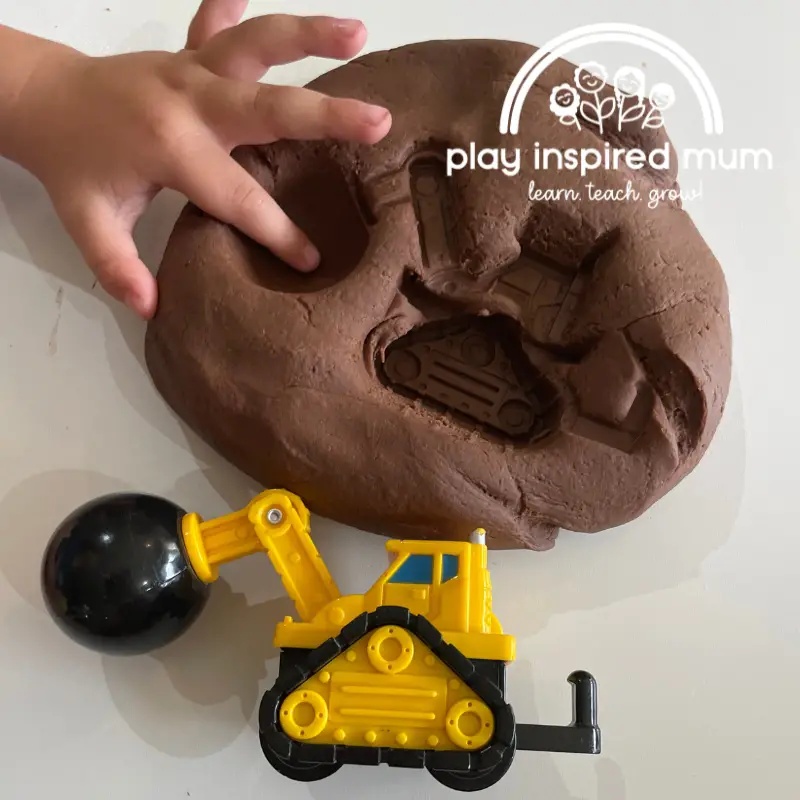
Exploring Sensory Play
Exploring sensory play enriches childhood development in profound ways. It engages a young learner’s senses, paving the way for enhanced cognitive growth, fine motor skill development, and creative problem-solving abilities.
Making homemade chocolate play dough offers a delightful sensory experience.
The soft, malleable texture invites tiny hands to squish, mold, and shape, stimulating tactile feedback.
The rich chocolate scent awakens the olfactory sense, merging with the tactile stimulation to create a comprehensive sensory activity.
This easy play dough recipe, beyond being a fun rainy day or toddler activity, serves as a foundational educational tool.
It introduces children to sensory play’s benefits in a familiar, engaging context.
You and I, we understand the importance of integrating sensory play into early learning.
Crafting homemade chocolate play dough together not only fosters a sense of accomplishment but also embarks us on a journey filled with sensory exploration.
The process itself – measuring, mixing, and kneading – further refines our fine motor skills.
Indeed, chocolate play dough, versatile and easy to create, stands as the best ever tool for immersive learning through play.
Developing Fine Motor Skills
Playing with chocolate play dough, a task that may seem simple at first glance, offers profound benefits in enhancing fine motor skills among toddlers.
Every squish, roll, and shape made by their little hands serves as a crucial exercise in muscle development and coordination.
I’ve noticed with glee how these easy play dough activities engage not just the senses but also the intricate movements of fingers and palms.
Take, for instance, the versatile play dough activity of rolling it into balls to mimic chocolates.
This action requires precision, aiding children in mastering the dexterity needed for writing and other daily tasks.
As they press, pinch, and manipulate the homemade play dough, their grip strength improves significantly.
Folding the sensory play into teaching moments, I’ve crafted playful challenges where precision and care come into play.
Creating shapes from the best ever chocolate play dough not only delights them with its aroma but also encourages patience and attention to detail.
This blend of sensory fun and fine motor skill enhancement turns every rainy day into a bustling hub of creativity and growth.
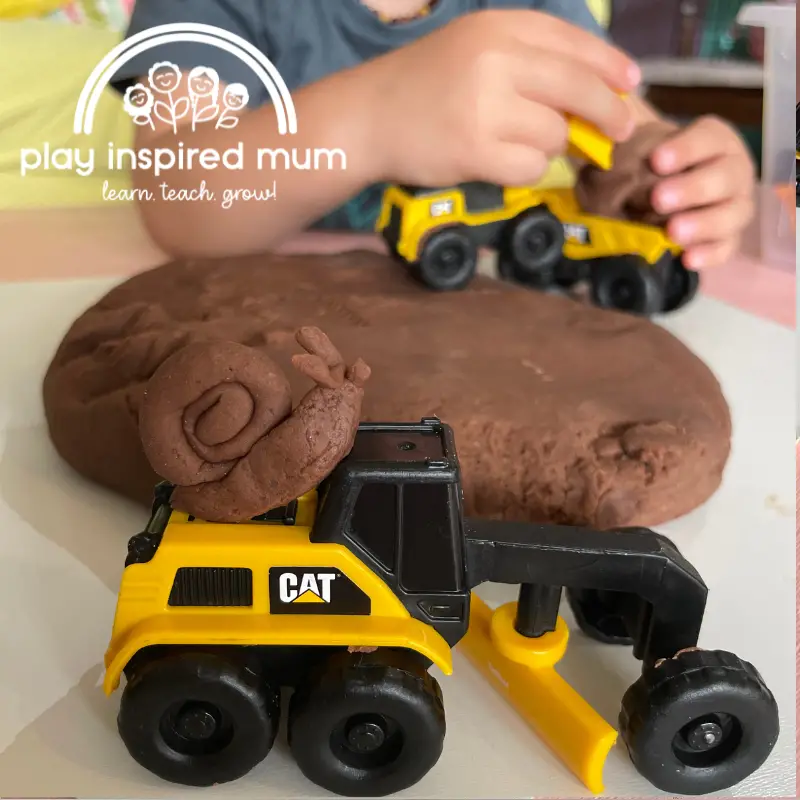
A Rainy Day Savior
Have you ever faced a rainy day with a restless toddler underfoot?
I discovered that homemade chocolate play dough offers a magical solution.
With its easy play dough recipe, this activity turned our gloomy afternoon into a delightful sensory adventure.
My toddler was completely absorbed in creating and exploring the versatile play dough activity.
It proved not only to engage their fine motor skills but also fueled their imagination.
Using just a few simple ingredients, we whipped up the best ever chocolate play dough.
It smelled wonderful and felt incredibly soft in our hands, putting those store-bought versions to shame.
As the rain pattered against our windows, we rolled, shaped, and molded our very own chocolate creations.
This sensory play was so much more than just a toddler activity; it became our rainy day savior, transforming a potentially frustrating day into an opportunity for learning and laughter.
I found that the act of making and playing with play dough alongside my child fostered a connection that brightened even the dullest weather.
Versatility of Play Dough Activities
I’ve discovered that making homemade chocolate play dough isn’t just a fun experiment; it’s an entrance into an expansive world of sensory play and learning.
The versatility of play dough activities is astonishing.
With this easy play dough recipe, we can transform a simple rainy day into a dynamic learning experience for toddlers.
Children can dive into sensory play, enhancing their fine motor skills while unlocking their creativity.
Through shaping and molding, little ones practice dexterity.
They learn about textures and shapes, grasping the basics of geometry in a tactile manner.
Imagine them rolling the dough into balls or crafting heart-shaped figures for Valentine’s Day.
This not only entertains them but also serves as a hands-on approach to education.
The chocolate play dough recipe I’ve shared invites kids into the kitchen, blending art and science.
As they measure ingredients and observe the dough form, they engage in early math and science lessons.
Who knew that a versatile play dough activity could turn into an impromptu lesson in measurements and states of matter?
Indeed, embracing the joy and potential of homemade play dough opens up a world where play meets unlimited learning possibilities.
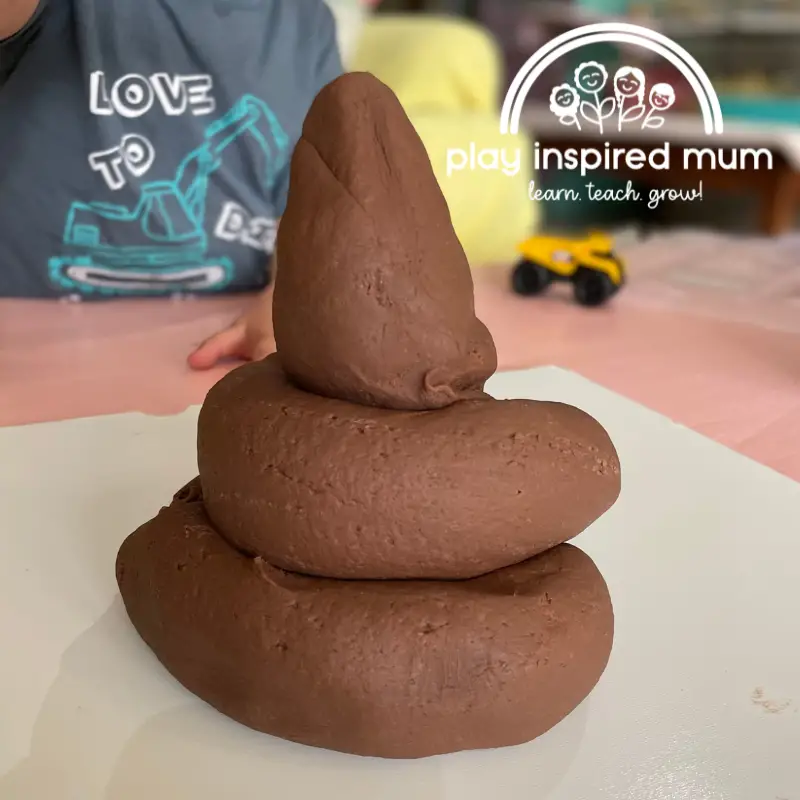
The Sweet End to Our Play Dough Journey
We navigated the journey of creating the best ever chocolate play dough together.
From gathering simple ingredients to mastering the easy play dough recipe, we embraced the joy of making something delightful and sensory.
Creating homemade play dough, especially one as unique and engaging as chocolate play dough, has proved to be a rewarding task.
The process involved more than just mixing and kneading; it was a foray into sensory play and fine motor skill development.
I saw how this versatile play dough activity could become a go-to for rainy day dilemmas or a fun toddler activity.
The texture, the smell, and the endless possibilities for creative play made our chocolate play dough the hallmark of engaging, educational fun.
But the journey doesn’t end with the last fold of dough.
We discovered tips for storing our play dough to keep it soft and pliable for future adventures.
I learned the significance of homemade over store-bought, not just in the quality but in the immersive experience it provides for us and the young ones we share these moments with.
Through this, the essence of sensory play and the development of fine motor skills became apparent, hallmarks of a well-rounded playful education.
In creating themed activities, like those for Valentine’s Day, we unlocked another layer of versatility.
These moments of rolling, shaping, and imagining with our best ever chocolate play dough are the sweet end to our play dough journey.
Yet, the door remains open for more discovery, creativity, and joy in the endless possibilities that lie ahead.

